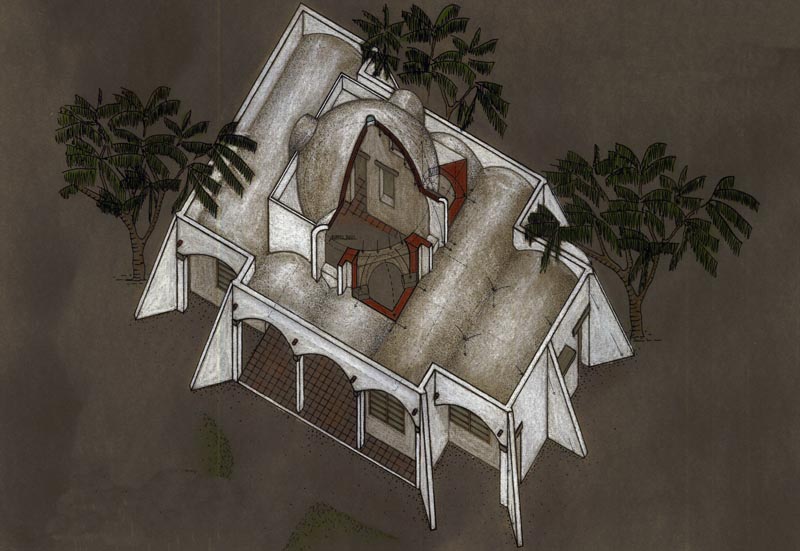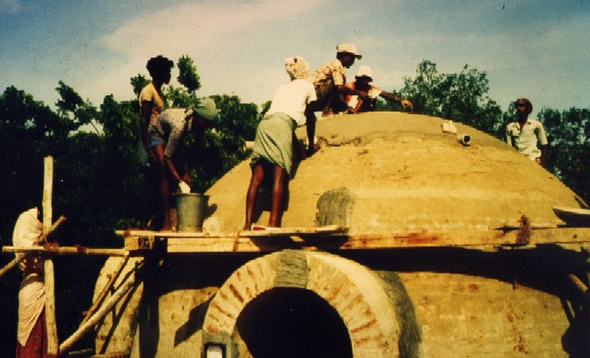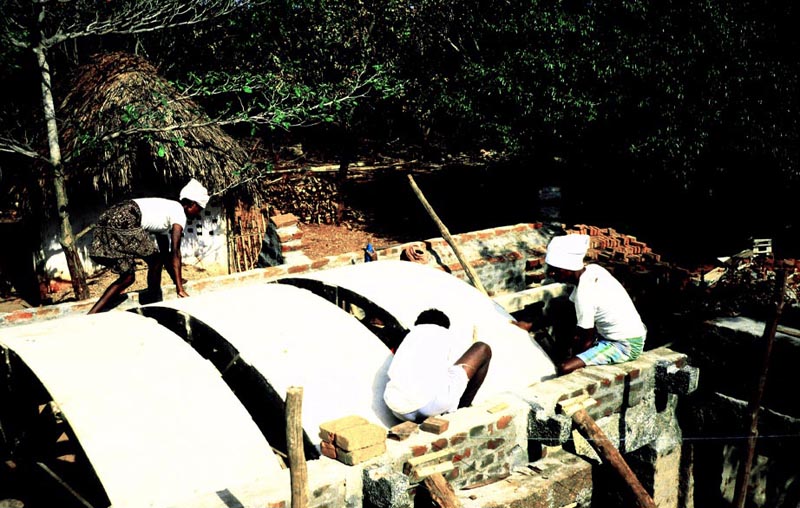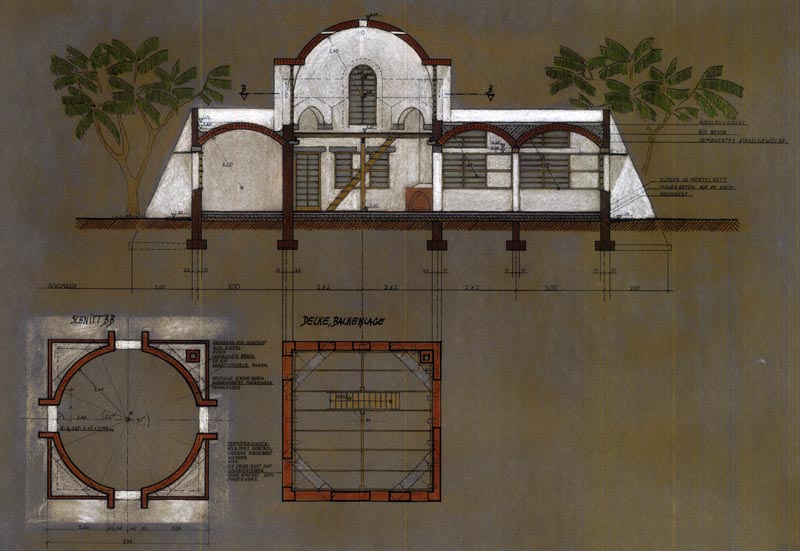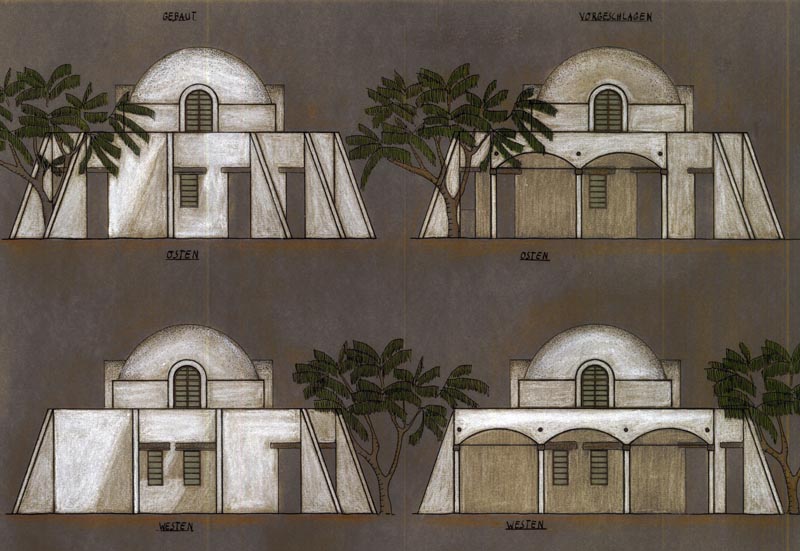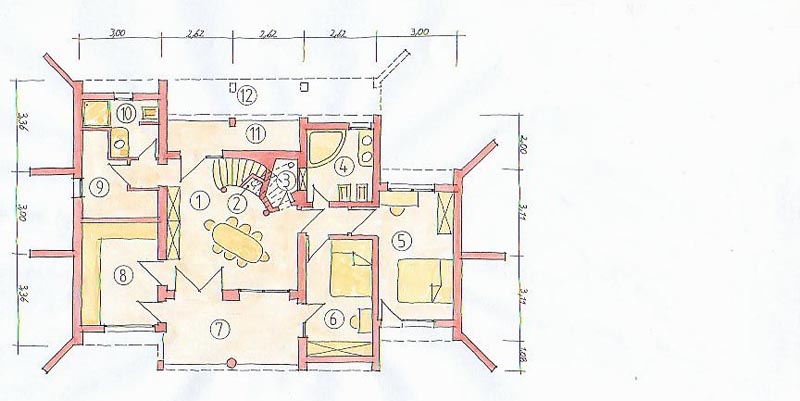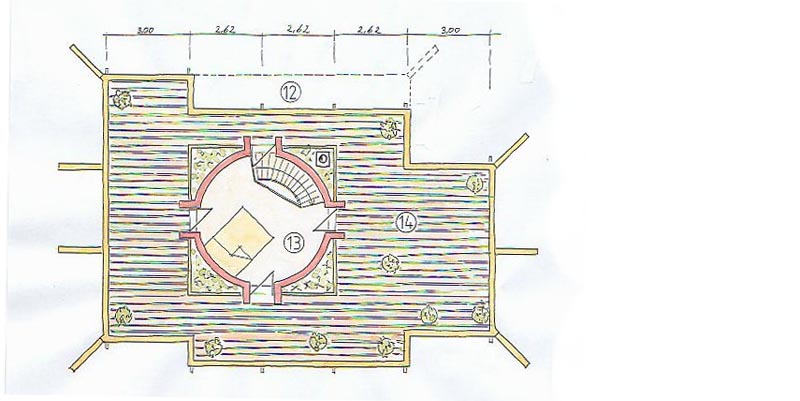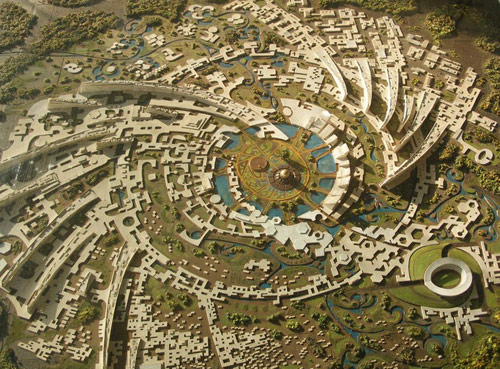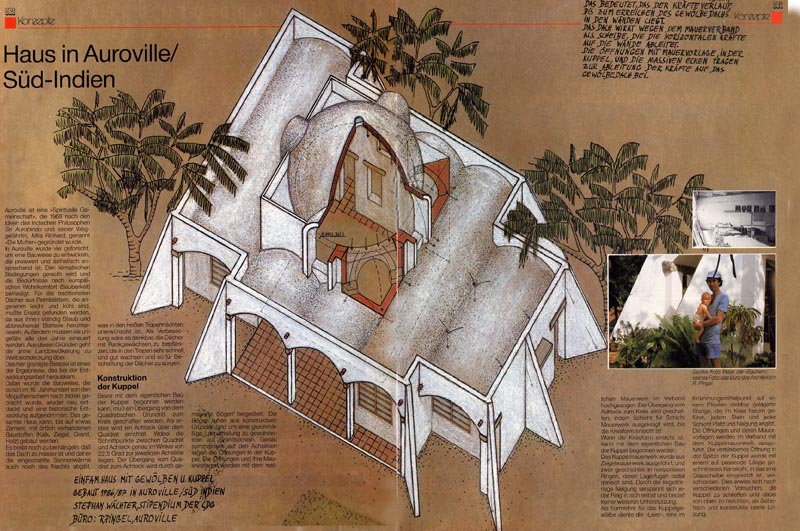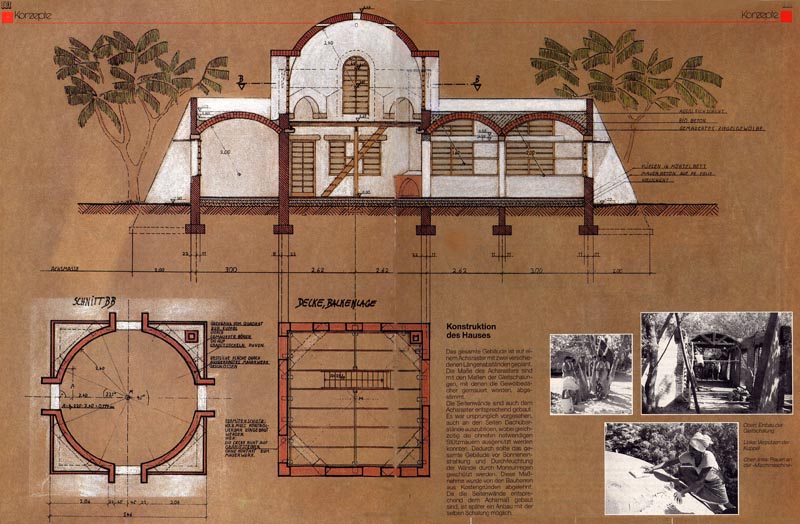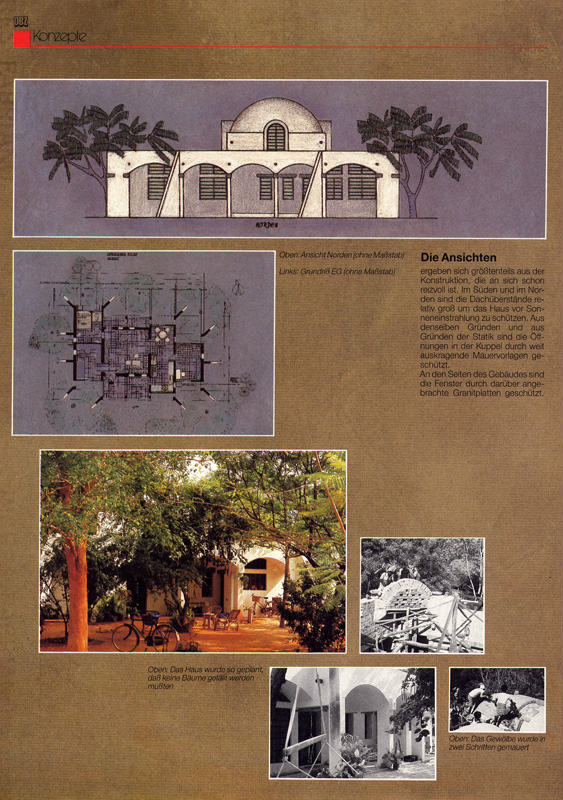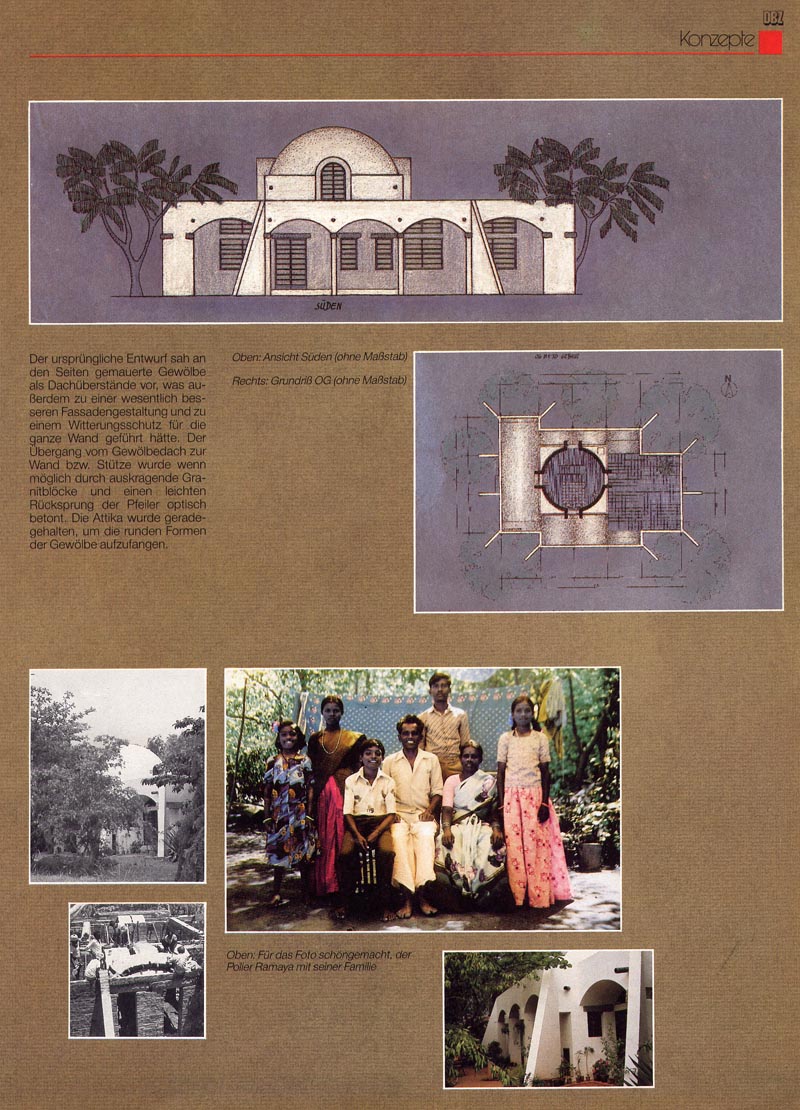Construction Project in Auroville - South India
Stipend of CDG Cologne, published in DBZ a German Construction Magazine
Auroville is a “spiritual community”, which was founded 1968 by the Indian philosopher Sri Aurobindo and his companion Mira Richard.
To find a construction style, that is cheap as well as attractive, they did a lot of researches. It had to conform to the local climate conditions and meet the demands of the European lifestyle expectations, like cleanliness for example. The traditional rooftops, covered with palm branches had to be replaced, as they would be covered with dirt and dust. Even though they did not weigh a lot and they keep the place comfortably cool. Moreover they had to be replaced every 3rd years. The solution for the poorer population was the use of corrugated iron sheets as rooftops. One of the results of the research project is the example illustrated over the following pages.
It reflects the construction style that was brought to India by the colonial patriarchs around the 16th century and so with picks up a historical process. Except for a small quantity of cement it can easily be built with local material (limestone, brick, granite and wood). According to the plans for the construction of the building, the plot was left more or less untouched in its original and organic condition. No trees were damaged or taken out, so the house would fit perfectly into its natural environment. There is though one minor aspect that could be criticized. Which is the rooftop; it is too big and is solidly built. Therefore the heat of the sun is accumulated throughout the day into the night time. With high temperatures finding in India, this is definitely undesirable. An improvement would be to cover the roofs with fast growing climbing and winding plants that keep the rooftops shaded and at a good temperature.
Before the actual construction of the cupola could kick off, a transition from the square ground floor plan to a circle has to take place. This means an octagon is constructed from the original square by dividing each 1/4 of the square into 4 sections of 22,5 degrees, measured from the horizontal part of the axis and connecting to the points where the angles meet with the outside lines of the square. The transformation from square, via octagon to the connecting base of the cupola is made by constructed arches that are mainly used to save on expensive material. The arches are based on granite bases; this has constructive reasons and guarantees that the weight gets more evenly spread. From here the bricklayers get hoisted on the top of the now octagon-shaped surface and adjusted more and more, till the construction matches a circular shape, which is the actual base for the cupola.
To caulk the in between spaces of the circularly arranged brickwork, they are sloped in a radial manner and therefore support themselves. As every new layer has enough tension between them to do without additional support. To make sure that the round shape of the cupola is balanced and the measurements of the spacing in between the centre and the wall is levelled at every point, a rotating rod gets installed on the top of the centre point inside of the cupola. By turning it clockwise it automatically measures and indicates the right position for every brick and every layer. There are four openings in the form of arches cut out of the cupola. According to the ground plan they are situated right on top of the meeting point of the axis lines and the outside lines of the square, this centres them right in the middle of each wall on the first floor. Their top end gets adjusted to the shape of the cupola and gets hoisted in accordance with the rest of the bricklayers.The very top end of the cupola gets finished off with an adjusted tube that is closed on one end with a glass disk. After trying a few other options this is the ideal and the most practical solution.
The whole construction of the building is based on a grid pattern, consisting out of two different dimensions. The measurements of the floor pattern are coordinated with the measurements of the sliding formwork used to construct the vaults of the ceiling. To optically emphasize and improve the transition in between the vaults and the columns or the walls, the columns have been placed slightly backwards towards the inside. Granite blocks have been installed on top of the columns, and function as a connection from there to the lowest point of the vault.
The original plan was to extend the roof towards the edges on the sides of the building and create something like small porches. This would have protected the building from humidity, over intensive solar radiation, all weather conditions and would have given use to the supporting sidewalls. This idea was rejected by the building owner to keep the costs low. Still there the possibility to extend the building at a later point with an annex. The perspective views result mostly out of the construction which is in itself most appealing. The originally planned porches would have improved a lot the appearance of the building. The protective idea is as well the reason why the open spaces in the cupola are fitted with arched extensions build from brick. As they are brought forward slightly they do shelter the inside from over extreme sunlight, falling leaves and dirt.
House |
|
|
|
Basic Model |
|
|
|
Ground floor |
| Area |
|
1 | Living room | 20,24m² |
|
2 | Living room |
|
|
3 | Storage under Stairs | 1,80m² |
|
4 | Bathroom | 6,24m² |
|
5 | Bedroom 1 | 13,44m² |
|
6 | Bedroom 2 | 10,32m² |
|
7 | Porches 1 |
| 12,50m² |
8 | Kitchen | 10,64m² |
|
9 | Utility room | 5,56m² |
|
10 | Bathroom with Shower | 4,78m² |
|
11 | Porches 2 |
| 6,24m² |
|
|
|
|
| Living Space Ground Floor | 73,02m² |
|
|
|
|
|
Constructed surface | (gross surface) | 111,75m² |
|
|
|
|
|
1st Floor |
|
|
|
13 | Bedroom | 13,86m² |
|
14 | Roof terrace | 83,36m² |
|
Constructed surface | (gross surface) | 21,23m² |
|
|
|
|
|
| Living space 1st floor in total | 13,86m² |
|
|
|
|
|
Living space total | house basic model | 86,88m² |
|
Constructed surface house in total | house basic model | 132,98m² |
|
Occupation | basic module | 121,12m² |
|
|
|
|
|
Extension modules |
|
|
|
12 | Extension Porches 2 | 9,36m² |
|
| Occupation | 9,36m² |
|
| Constructed surface | 4,68m² |
|
|
|
|
|
Living space house in total, max. | 86,88m² |
| |
Constructed surface house in total, max | 137,66m² |
| |
Maximum occupation | 130,48m² | ||

